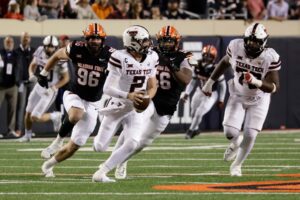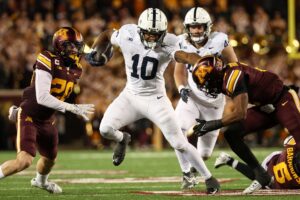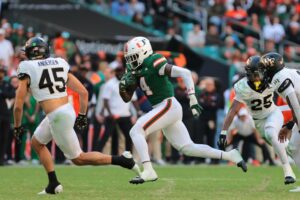Justin Fields was one of two Buckeyes on the Heisman podium last season because of his efficiency as a passer. He can thank the stable Ohio State running backs position for taking the pressure off of him at times.
Ohio State RB Position Break Down
Replacing J.K. Dobbins
Fields got a lot of help from J.K. Dobbins, who was an absolute workhorse in 2019. He carried the ball an astounding 301 times for 2,003 yards. Only three players in the country had more carries, and only three had more yards.
Dobbins will be leaving a gaping hole in the roster in the wake of his decision to go to the NFL.
Ohio State has always been a good place for running backs to develop. The Buckeyes have boasted a 1,000 yard back every year since 2013. The year before, Carlos Hyde only rushed for 970 yards while Braxton Miller rushed for 1,271.
The presumed starter heading into the spring will be Master Teague. The redshirt sophomore carried the ball 135 times for 789 yards last season, which would be a starter’s workload at many other programs.
Sophomore Marcus Crowley and redshirt freshman Steele Chambers will also be in the mix. Crowley had 25 carries in 2019, and Chambers had 19. Since no running backs are coming in from the 2020 recruiting class, these are the only two that could supplant Teague for the starting job.
Master Teague
Though Teague had decent production for a freshman backup, his game isn’t perfect. Most of his carries were in the second half of games where the opponents were clearly over-matched and worn down. Though he averaged 5.8 yards per carry, in his last four games he rushed 31 times for only 91 yards. That 2.9 yards per carry mark came against Rutgers, Penn State, Michigan, and Clemson; three of those four were among the toughest opponents the Buckeyes faced all year.
Part of the legend of running backs like Dobbins, and Ezekiel Elliott is that they seemed to grow stronger when the pressure was at its greatest.
In 2019, Dobbins had under 20 carries against Cincinnati, Miami (OH), Northwestern, Maryland, and Rutgers. He also only had 18 carries against Clemson in the Fiesta Bowl, but balanced out the low figure with a 9.7 yard average.
Against tougher opponents, like Penn State, Michigan, and Wisconsin in the Big Ten Championship, he carried the ball 31 times or more.
The same was true of Elliott. Imagine a national championship run where Elliott doesn’t rush for 200 or more yards in each postseason game. Does Ohio State achieve the same success under Cardale Jones?
Teague was absolutely dominant against teams like Indiana, Northwestern, Michigan State, and Maryland. In games against those teams, he had double digit carries with 90 or more yards. But those teams were a combined 19-30, and only Indiana had a winning record in conference play.
Teague’s style of play and skill set limit his chances of success. He is a strong runner that can break arm tackles at the line of scrimmage, and once he has a head full of steam he is nearly impossible to bring down.
But he lacks elusiveness and the ability to create plays in the backfield. He has the greatest success when there are holes at the line of scrimmage. With his strength and vision, once he finds a gap, he’s off for a huge gain.
However, he gets stuck behind the line against tougher defenses.
When the Buckeyes were playing against Indiana and Northwestern, their offensive line was able to dominate the line of scrimmage. But Teague was left to create for himself against teams with better defensive lines, like Michigan and Clemson. This resulted in him often getting caught in the backfield for negative yards.
This isn’t to say that Teague will be a bad running back. Teague will still be pretty good. But the running game will have to take a step back. Dobbins didn’t grow on a tree, so there is no clear replacement for him.
Marcus Crowley
Behind Teague, Crowley will most certainly have an expanded role in 2020.
The Buckeyes opted not to redshirt Crowley last season, so as a true sophomore, they have big plans for him.
Crowley is taller than Teague, and about 15 pounds lighter. This, with his agility and elusiveness, makes him a perfect complement to Teague’s style. If Teague becomes the bell cow back, Crowley will be a perfect change of pace back, and will probably be on the field on passing downs.
If Teague loses the starting job this spring or summer, it will be Crowley that takes up the mantle.
Steele Chambers
Finally, there’s Steele Chambers, who only played in four games and was subsequently redshirted last season. He’s Teague’s weight and Crowley’s height, and is a mix of the two. He is a blend of Chambers’ quickness and Teague’s strength.
Right now, Teague has the highest chance of taking the starting job at the running back position. But even if he does, he won’t quite have the same workload as Dobbins had. He will split a good portion of his snaps with Crowley. Chambers will be the third of three talented Ohio State running backs.
The Buckeyes won’t have the same rushing attack as they did last season, but that’s OK. Dobbins was the program’s first-ever 2,000-yard rusher. You can’t just replace that kind of production with the snap of a finger.
With another year of development for Fields and an influx of athleticism at wide receiver, the passing game will take a lot of pressure off the run. The Buckeyes won’t need Teague or Crowley to be Dobbins.






